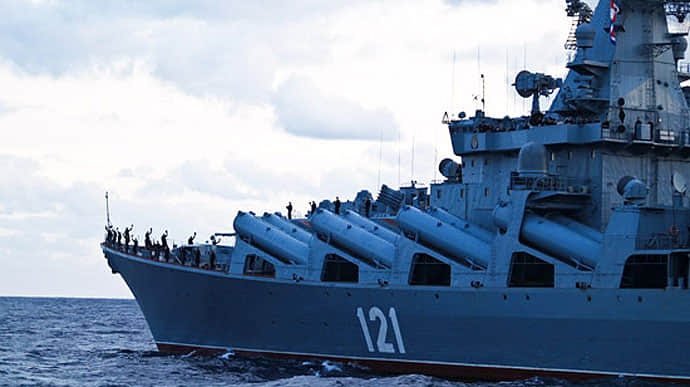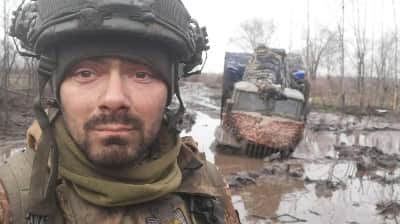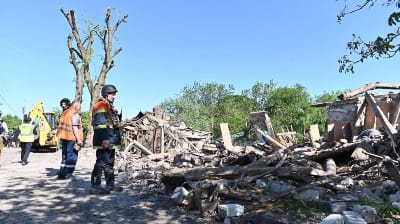Navy Commander describes what Moskva cruiser looked like: 7 floors, lifts, swimming pools and Russia's pride

The cruiser Moskva, which was destroyed by the Ukrainian Navy in April 2022, had seven floors, a lift and a swimming pool, and had undergone a major renovation just before the full-scale invasion; this flagship was the real pride of Russia, and it was precisely because of the presence of the Moskva vessel that Russia had a fleet, not a flotilla.
Source: Vice Admiral Oleksii Neizhpapa, Commander of the Ukrainian Navy, in an interview with Ukrainska Pravda (the interview will soon be translated into English)
Quote: "She is a flagship. If there is no cruiser, in the long run, a fleet cannot be called a fleet. Without a cruiser, a ship of the first rank, it is called a flotilla. This understanding of ranking has been accepted as mandatory since the Soviet Union.
Now their flagship is the Admiral Makarov frigate, not a cruiser. By old Soviet standards, she was a second-rate ship. Now, probably, her rank has been raised, because she is still a carrier of Kalibr missiles. So the Moskva cruiser was precisely the flagship of the fleet."
Details: Neizhpapa reiterated that the Moskva cruiser was built in Ukraine, in Mykolaiv. Her first name was Slava (Glory).
She was named Moskva after a petition from the mayor of Moscow, when the previous Moskva vessel, a large anti-submarine aircraft carrier, was decommissioned and the Russians needed someone to name her after the Russian capital.
Neizhpapa said that since then, the vessel has been the focus of the attention of Russian President Putin, who has visited the cruiser on several occasions, and of the then-mayor of Moscow, Yurii Luzhkov, and his successor, Sergei Sobyanin (who is now the mayor of Moscow).
Quote: "She was the pride of the Black Sea Fleet. The cruiser took part in all the conflicts of the post-Soviet period: in the war with Georgia, she was used to control all the fleet forces off its coast, she was in Syria and in the area of other conflicts."
Details: He also said that before the full-scale aggression, the cruiser had undergone a complete renovation, and Russia had invested a lot of money in her modernisation.
Neizhpapa explained that from the military point of view, the Moskva was designed for the ocean, not the Black Sea.
The sea, he said, is too small for a cruiser carrying cruise missiles with a range of 500 kilometres. This flagship was designed during the Cold War to destroy US aircraft carriers and was called the "aircraft carrier killer", even though there are no aircraft carriers in the Black Sea.
Quote: "The Moskva could be used as a good command post. She had large flagship cabins. Just so you know, I think there were seven floors. There was a lift to go from the main command post, which is below the main deck, to the bridge. Seven decks that the lift goes through! Well, so that the commander or the senior officer on the commanding officer’s bridge did not have to walk. There was a swimming pool. In other words, the ship provided very comfortable living conditions for personnel onboard for long voyages.
And, of course, the Moskva covered the main issues of air defence: she was equipped with detection systems, electronic warfare, and a naval version of the S-300 air defence system called Fort. It was a type of umbrella air defence over the ships of the order (the order of deployment of ships during a campaign or battle – UP)."
Details: Neizhpapa stressed that the Moskva served several functions: a command post, an air defence ship, and a symbol that "Moscow came with the war".
He also said that he was overwhelmed with emotion when he realised that the Moskva had been struck.
"Of course, there were emotions. But we hadn't yet comprehended the significance of the moment. Because the war was still ongoing, tomorrow someone might come again, we had to work with cruise missiles or whatever. There was no time to sit around and feel some kind of great victory, the situation was very tense at the time.
Yes, there was joy, of course, that Ukrainian weapons had been so successful. Of course, this was a historic moment. But for me personally, it somehow passed very quickly," Neizhpapa concluded.
Read more on the topic: Sinking the Moskva: previously undisclosed details. How the Ukrainian Neptune destroyed the flagship of the Russian fleet
Support UP or become our patron!







